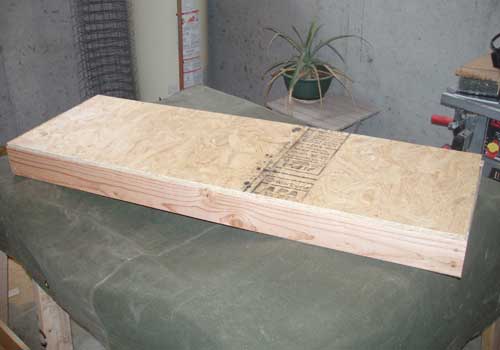If you have an unfinished basement, a garage or a storage shed, you can store much more in it if you have shelves. Built-in shelves are great, but if you’re renting or want the flexibility to rearrange the shelving units, you could make some free-standing shelves. Here’s a simple method for building some inexpensive wood storage shelves — and you can build them without power tools.
Materials to make two shelving units:
- 1 1/2-inch-thick sheet of plywood or oriented strand board (OSB). A full sheet is 4-feet-by-8-feet. Cost: about $7.50
Process:
1) Cut the 4-foot-by-8-foot sheet of plywood or OSB into six pieces that are 4 feet by 16 inches. This requires five cuts. The lumberyard or building center where you buy the materials might cut the plywood for you if you don’t have a power saw. Accounting for the width of the saw blade, these pieces will be slightly less than 16 inches wide.
2) Cut 12 pieces of 2-by-4 to 13 inches, for the end supports of the shelves.
3) Cut six of the 2-by-4s in half. These will be slightly less than 48 inches and used to support shelves between uprights.
4) Make six frames for the shelves. Put the 13-inch pieces between the ends of the 48-inch pieces and join each corner with two screws.

5) Attach the plywood pieces to the tops of the shelf frames with screws — two on each long side at least, more if you’d like. Note that the OSB will likely have a smooth side and a rough side. Keep this in mind as you attach it to the frames. Either side will work — this is only personal preference.

6) Attach an 8-foot 2-by-4 to each corner of the shelves, three shelves per unit. Use two or three screws per joint. You can pick a height for each shelf that works for you. Try to keep the shelves as level as possible.
7) Set the shelves in place.
Tips:
- Adding a diagonal brace across the backs of the shelves will make each unit more sturdy and less likely to “fold up” under the weight of items stored on the shelves. If you use nails instead of screws, the diagonal brace is a necessity.
- For safety, attach at least one corner leg to a ceiling joist or something secure to stabilize the unit.
- If the shelving units aren’t perfectly level, you can use shims to level them — or use the method for leveling a table from Build Your Own Table (scroll down to “Make Your Table Stable”).
- The legs can be shorter than 8 feet. You might want to trim these to fit your space. I cut 13 inches from each and used those pieces for the frames, so I had longer leftover pieces.







